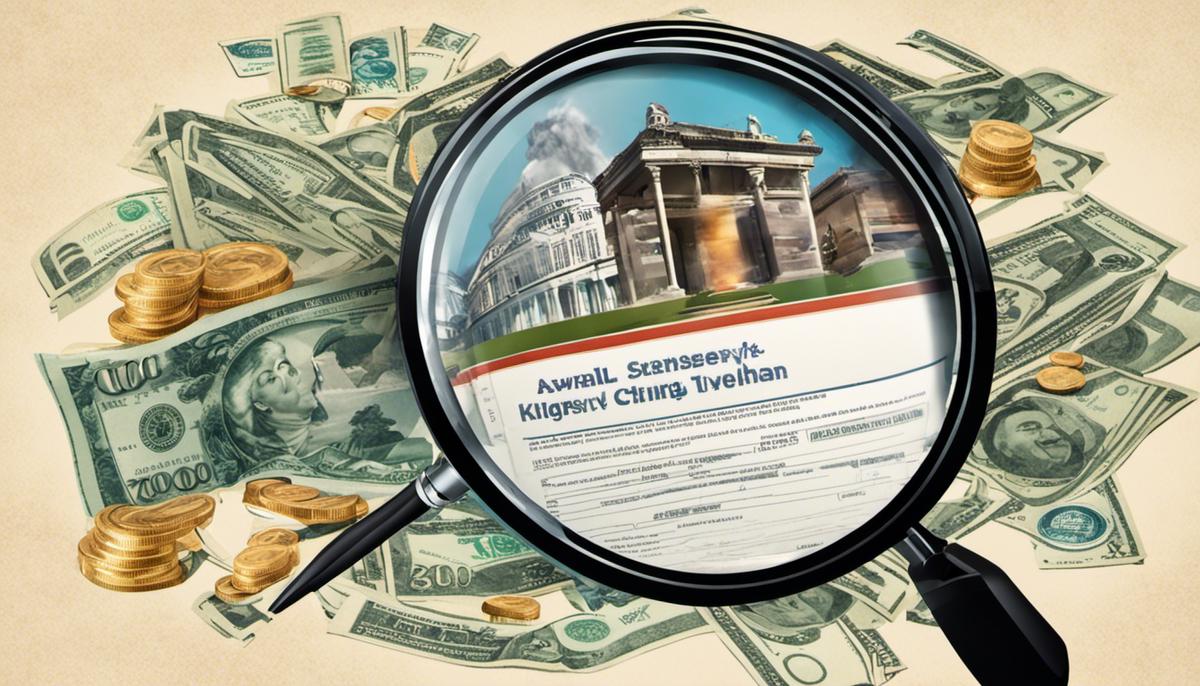Understanding and strategically managing personal finances is an instrumental part of life in our modern world. Financial stability and security don’t happen by chance but require careful planning and conscientious decisions. This multifaceted area includes components like establishing clear financial goals, creating a budget plan, investing wisely, managing and evaluating risks, and continuously monitoring and reviewing financial progress. In the context of an uncertain and volatile economic environment, adhering to a well-defined strategy ensures that individuals can effectively navigate their way to financial security and prosperity.
Table of Contents
Establishing Clear Financial Goals
Creating a solid personal financial strategy can often resemble a daunting challenge but the importance of this implementation cannot be overstated. At the heart of this strategy lie one’s distinctive financial goals. These clearly defined objectives play a key role in crafting a robust financial plan. They assist individuals to streamline their economic activities, keeping them focused on creating and maintaining a financially secure future.
In order to thoroughly understand the significance of these clearly defined financial goals, let’s delve deeper. Just as a tech-business startup needs a detailed business plan to attract investors, an individual needs a well-thought-out financial plan to direct their finances towards their future vision. The motive is to keep short-term desires in check and focus carefully on long-term wealth building.
Consider the role of a captain steering a ship. The ship’s destiny is the captain’s goal. The captain plots the ship’s route, navigates it through storms and obstacles, and continually adjusts the course to keep the ship headed towards its ultimate aim. Similarly, in the world of personal finance, clearly defined goals act as the guiding compass in the sea of financial decisions, illuminating the path through complex investment options, providing a roadmap for debt management, and directing investment towards wealth creation.
Moreover, establishing these goals entails more than simply having an idea of what you want. A nebulous desire to “purchase a home” or “retire comfortably” does not suffice. It is the process of clearly outlining the specifics—how much money is needed by what date—that transforms these desires into actual, achievable targets.
Also worth noting, these goals provide a measure for success. By regularly comparing actual financial status with desired objectives, course corrections can be made swiftly when off track, increasing the likelihood of eventual success. In essence, these quantifiable objectives provide a feedback loop, allowing individuals to optimize their financial behaviors and strategies over time.
Furthermore, these financial goals frame the adoption of prudent risk management. For instance, risk tolerance can vary greatly depending on whether the objective is retirement planning or buying a first home. By setting specific financial goals, the capacity to accept risk can be evaluated, and more fitting investment options can be selected. Consequently, this risk management maximizes the potential to attain desired financial milestones in a timely manner.
In conclusion, clearly defined financial goals lay the bedrock of a personal financial strategy. They provide clear direction, set the benchmark for success, enable active risk management, and most importantly, help resist the magnetic pull of impulsivity, facilitating the creation of lasting wealth and financial security. As the future can often be a murky ocean of unpredictability, having carefully crafted financial goals is akin to having a sure-fire compass, guiding towards assured financial success.

Creating a Budget Plan
Stepping forward into the financial playing field, one might be armed with solid goals and a clear direction, yet left in the dark without the right tool – a comprehensive budget plan. Known to accomplished industry leaders as a fundamental part of an effective personal financial strategy, budgeting, despite its simplicity, channels unparalleled power into realizing financial ambitions, steering the ship towards solid fiscal ground.
When budgets marry goals, a fiercer force is born. With clear financial goals guiding your decisions, a budget becomes your compass, color-coding your decisions with a practical perspective. It outlines your every income, expenditure, investment, and saving, offering you an unclouded vision of where your money originates from and its final destination. By painting a vivid financial picture, it brings clarity to the abstract realm of numbers, transforming theoretical financial goals into tangible results.
Let’s dive into an often-overlooked benefit – adaptability. The financial climate is ever-changing, laden with uncertainties. Take for instance, the stock markets. Volatility is at its core. Without a contingency plan, one wrong turn could stir a financial storm. Here, budgeting swoops in as your financial lifeguard, integrating your definitive goals with a flexible strategy that affords room for adjustment. It ensures stable footing even during seismic shifts, reinforcing your plan by factoring in unexpected expenditures, market fluctuations, or even income changes.
Apart from resilience, the role of budgeting extends into the realm of utilization. Resources, while abundant, are finite, requiring prudent distribution to realize maximum potential. A comprehensive budget serves as your money management protocol, dictating efficient allocation. It hones in on not just saving more, but spending wisely. By keeping a pulse on your financial rhythm, it empowers you to manage resources agilely aligning spending habits with desired objectives.
Shall we discuss the sweet taste of success? Well-planned budgets are conduits to reward. With a financial layout, not only do you get a clear snapshot of your income and expenditures, but also a method to systematically pursue personal financial milestones. It helps delineate a pathway that can expedite goals like homeownership, starting a business, or retiring comfortably – a fulfilling reminder that prudent planning breeds prosperity.
Let’s not forget impulse resistance. Armed with clear instructions about where the money should flow, a robust budget takes the reins when temptation strikes. It raises a red flag against reckless purchasing decisions, thereby cultivating disciplined expense habits and maintaining firm adherence to your financial strategy.
In essence, the age-old practice of budgeting, often considered tedious, is a formidable beacon that can illuminate the path to your financial destiny. It transcends beyond numbers on a spreadsheet, serving as a dynamic system – a brave heart throbbing at the nucleus of your personal financial strategy. The roar of a plan blended with the wisdom of budgeting is a symphony that resonates with successful financial health. Be the conductor, set the rhythm, and watch your financial objectives actualize.

Investment Planning
Undeniably, effective investment planning plays a pivotal role in the amplification of personal wealth. Coupled with strategic budgeting, clearly defined financial goals, and conducted alongside a thorough assessment of one’s risk profile, it creates a vehicle for wealth creation like none other.
Diving into this, investing is much more than just stowing away funds in a safe corner. It’s about channeling resources wisely to maximize returns, thereby augmenting overall wealth. Investments serve as catalysts for wealth multiplication, provided they are planned and managed with due diligence. Remember the age-old adage – ‘Don’t put all your eggs in one basket?’ It rings particularly true with investments. A well-diversified portfolio is a requisite to reduce overall investment risk and to smoothen the volatility of returns.
The investment planning process starts with identifying an array of financial products that align with the financial goals established in the initial phase. This demands looking beyond traditional stocks and bonds. Whether it’s real estate, index or mutual funds, precious metals, or innovative ventures – opportunity abounds for the discerning eye. The key is in striking a healthy balance between risk and reward, ensuring the investments are generating sufficient returns to meet the planned objectives.
Timing also holds a crucial conversation in this platform of wealth creation. Intentional investing is not only about what and where but also when. Masterfully entering and exiting the market can lead to significant wealth enhancement. Wading carefully through the ebb and flow of market conditions and seizing growth opportunities can drive the desired financial growth. An adept understanding of the global market scenario will allow for preemptive positioning of investment, thus escaping massive financial wipeouts.
Moreover, the use of technology should not be underestimated in investment planning. With the proliferation of digital assets and a host of tech-enabled tools to assist in investment tracking, it is easier than ever to manage and optimize investments for the highest returns.
In conclusion, effective investment planning serves as the fuel driving the engine of personal wealth growth. When it’s strategic, well-timed, diversified, and managed with acumen and expertise, it propels towards financial success. Continuous learning and staying abreast with market trends will assist in making well-informed decisions, while habitual revision and tweaking of the plan will ensure alignment with financial goals and personal wealth trajectory. The vital endeavor is maintaining a far-sighted perspective, embarking on the journey with patience, and remembering that the course to wealth, though not necessarily smooth, is certainly navigable and worth the ride.

Risk Evaluation and Management
As we deepen our exploration of personal finance, we see a crystal clear correlation between risk management and financial security. Financial risks can be potential hazards waiting to disrupt the smooth journey towards accomplishing your financial goals. At the same time, risk is an inherent part of the financial world. It’s not about completely avoiding risks, but more about identifying, measuring, and managing them effectively.
Risk assessment and management serve as a financial radar, helping to spot potential dangers before they materialize. It’s not always comfortable, but a strategic, calculated approach will help you steer clear of financial snags. The entrepreneur will understand that similar to operating a business venture, personal finance also comes fraught with risks, and developing an eye for these hiccups can mean the difference between success and failure.
Credit risk, market risk, operational risk, liquidity risk, business risk, and inflation risk are some of the typical financial risks that one should understand and look out for. Thorough risk assessment and management underline the fact that personal finance is not a one-size-fits-all approach but should be customized based on individual risk appetite.
For instance, younger adults may be more comfortable with high-risk, high-reward financial products as they can afford to wait out market volatilities. In contrast, individuals nearing retirement may prefer secure, low-risk investments that provide a steady stream of income. Proper risk assessment helps align financial decisions with personal circumstances and financial goals, significantly reducing financial stress.
With the ever-evolving financial landscape, individuals may also face ‘new-age’ financial risks such as cybersecurity risk and climate risk. Remaining abreast with these developments enables the proactive adjustment of personal finance strategies, reinforcing their relevance in a rapidly-changing world.
Moreover, costs associated with risk mitigation activities like insurance proceed or hedging options also play a crucial role. Taking a step further, individuals could explore derivative instruments as risk mitigation tools, contributing to a comprehensive risk management strategy.
Lastly, one cannot overlook the role of continuous monitoring and timely intervention. Regular scrutiny of investments aids in identifying any deviations from planned financial growth. Monitoring market trends and realigning investments suitably provides an upper hand in managing risks. If navigated correctly, these financial risks can be transformed into opportunities, contributing positive growth to overall financial health.
In conclusion, mastering the art of risk management can propel you towards a secure financial future. It encourages a pragmatic, wide and detailed examination of your risk propensity and preemptive planning to tackle potential risks. Therefore, successful risk management is the critical interlink – the magic potion, you might say – that can robustly bind your diverse financial endeavours. Together, let’s celebrate the symbiotic relationship between risk management and financial success, making the path to financial freedom a journey of measured risks and assured returns.

Continuous Monitoring and Review
Monitor, Review, Adapt: Nourishing Financial Strategy for Sustainable Growth
Astutely assembled financial strategies require more than just creation. The need to regularly monitor, review, and adapt them is paramount for sustained growth. This entrepreneurial truism extends to industries vast and varied. The shrewd entrepreneur is akin to the experienced sailor, keenly aware that course-corrections are essential to navigate treacherous financial waters successfully.
Close Monitoring and Regular Review
An entrepreneur’s role doesn’t end at the helm of creation. It transforms, necessitating constant surveillance of economic conditions, industry trends, and market dynamics. This monitoring ensures timely adjustments to the financial strategy, akin to changing sails in shifting winds. Regularly reviewing financial progress prevents languidity and promotes a proactive stance, keeping one’s journey towards financial goals more taut and agile.
Dynamic Adaptation
Dynamic adaptation borrows principles from Darwinian evolution, affirming that only those financial strategies that adapt to market flux survive. A continuously evolving financial strategy, therefore, is unafraid of embracing changes. This approach keeps up with changes in personal circumstances, economic climate, or risk tolerance levels. Adaptation also broadens the financial palette, acknowledging growth opportunities in emerging sectors, technologies, and markets, subsequently capitalizing on them.
Holistic Financial Health
Continuous monitoring and review of the financial strategy facilitate comprehensive financial health checks. These checks identify underperforming areas, inefficiencies, and economic drifts that can be detrimental to the overall financial strategy, fostering preemptive actions. A healthy financial strategy further strengthens the entrepreneur’s resilience during economic downturns and shifting landscapes.
Attain Sustained Growth
Substantial, sustained growth from a financial strategy is a result of proactive adjustments, informed investment decisions, and calculated risks. Monitoring, reviewing, and adapting lay the groundwork to demystify complex dynamics, enabling the entrepreneur to stay at the helm of financial prosperities.
On the Horizon
No journey can be completed without continuous monitoring and timely course corrections. To overlook the need for regular review and dynamic adaptation is to jeopardize the voyage itself. The same holds true for financial strategy. Being vigilant, adaptable, and in tune ensures the strategy’s alignment with one’s financial goals.
This isn’t merely about reaching the destination. It’s about enjoying the voyage, weathering storms, and riding the waves to financial success.

Financial wellness is not a destination but a continuous journey that requires active participation, savvy foresight, and periodic calibration. Embracing a holistic approach that encompasses goal setting, budgeting, investment planning, risk mitigation, and continuous assessment can help individuals sculpt a resilient and profitable financial future. Personal finance management, when done right, yields multiple benefits ranging from immediate monetary stability to enduring financial growth and security. With the right tools and strategies, you too can master this journey, developing a financial plan that aligns with your lifestyle, fulfills your aspirations, and safeguards your future.

Lian Jadepeak is a Chartered Financial Analyst (CFA) with a sharp acumen for investment strategies and financial markets. With a background in finance and years of experience in wealth management, Lian offers readers expert insights into smart investing, market trends, and portfolio management. Her clear, analytical approach helps demystify complex investment concepts for both seasoned and novice investors alike.

